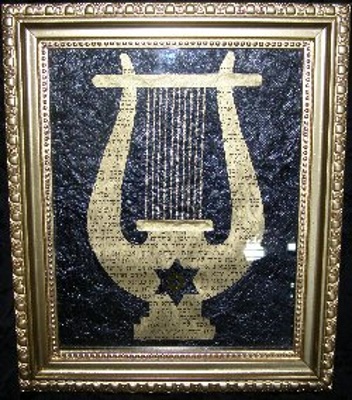During the ancient times of Israeli history, art
was not the same as it is now. There were no drawings, paintings, or sculptures
because it was widely thought that this type of art was in direct violation of
the second commandment, which read that there should be no graven images. I
think that’s open to interpretation, but at that time it was accepted without a
second thought. And unlike other areas, this area was fairly resistant to any
kind of European influence when it came to other artistic movements or styles.
But in order to express themselves artistically, these artists excelled in
developing highly decorated borders, mostly based on geometrical shapes. These
borders were found on various pieces of furniture as well as religious
figurines and objects. Other works of art during this time include decorative
soaps, embroidery, gold work, silver work, and rubber stamps.
It wasn’t until the late 19th century and
beginning of the 20th century when artists from Europe and other
areas began to flock to the Holy Land in order to use its landscape as a
background for their paintings. In 1906 the Bezalel School of Arts and Crafts
was established as the first art school here. And because of the time in which
this school opened, the school and its artists delved right into the modern art
movements. They opened themselves up to many of the most up-to-date styles and
arts movements that were sweeping through Europe and the US at that time.
Students at this school excelled in painting, sculpture, jewelry making, and
other mediums.
 |
| Bezalel |
As the years and decades went on, many of the arts
students who studied at Bezalel formed groups based on similar artistic styles,
philosophies, and political views. There were also many styles that became
popular throughout the years and then gave way to others. During the 1920s many
of these artists were embracing Israel as a modern society, and artists
utilized art forms never seen before such as abstract art. Armenian ceramic art
was also popular during this time as well. From the time just before WWII to
around the time of their independence in 1948, many Israeli artists were
looking to what French and German artists were doing. Realism, cubism, avant
garde, and photography were quite the rage. The avant garde movement actually
lasted well into the 1960s.
As Israel began to establish itself in the world as
an independent nation, art began to reflect those changes and the conflicts
that went along with it. Social art depicted how life was changing, and it was
their best means of expression; it became a voice of the people. Art became a
form of silent protest. During the 1970s and 1980s, public art (mainly in the
form of sculptures and architecture) began springing up in cities and towns
across Israel. Throughout the recent decades, Israeli artists have certainly
shown a penchant for taking an issue or a message or a style and stretching it
further than before to make a point (especially if the point was ugly to begin
with).
| The Mishneh-Torah |
Literature in Israel is typically written in
Hebrew, but some writers also write in English, Arabic, or Yiddish. Yiddish is
a language that was spoken primarily by the Ashkenazi Jews (those who lived in
Central and Eastern Europe). While it uses the Hebrew script, Yiddish grammar
draws heavily from German, various Slavic languages, Aramaic, and Hebrew.
The most famous works of literature from the early
period were religious texts: the Bible, the Talmud, the Mishna, and the Torah.
But there was also a fair amount of poetry and fables written as well. As
Jewish writers entered into the modern era of literature, they also introduced
other kinds of writing styles such as fiction, short stories and novels, drama,
and essay writing. During the 18th and 19th centuries,
many writers and poets began to translate famous European works into Hebrew,
such as Goethe’s Faust. At the same
time, Hebrew works were also being translated into other languages as well.
 |
| Shmuel Yosef Agnon |
Starting in the 20th century, some
writers like Eliezer Ben-Yehuda began taking on the effort of changing the role
of the Hebrew language from being primarily the language of religion and
classical poetry to one used as part of a modern society. There was a surge in
interest in Hebrew literature by Jews who were living in Europe. Shmuel Yosef
Agnon is the only Israeli to have been awarded the Nobel Prize for Literature
(1966). Amos Oz was another famous Israeli writer, famous for his novels My Michael and Black Box. Many of the
themes of late 20th century literature centers around the numerous
conflicts the country has engaged in and how life has changed during and after
those struggles.
Up next: music and dance



No comments:
Post a Comment